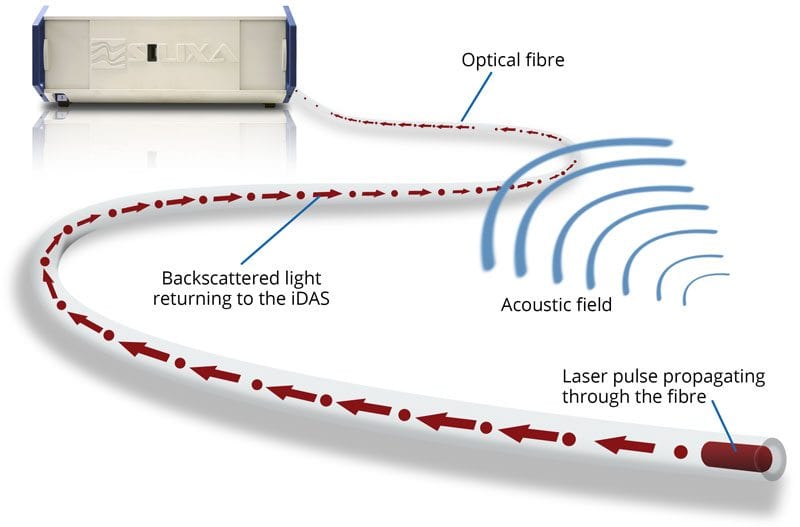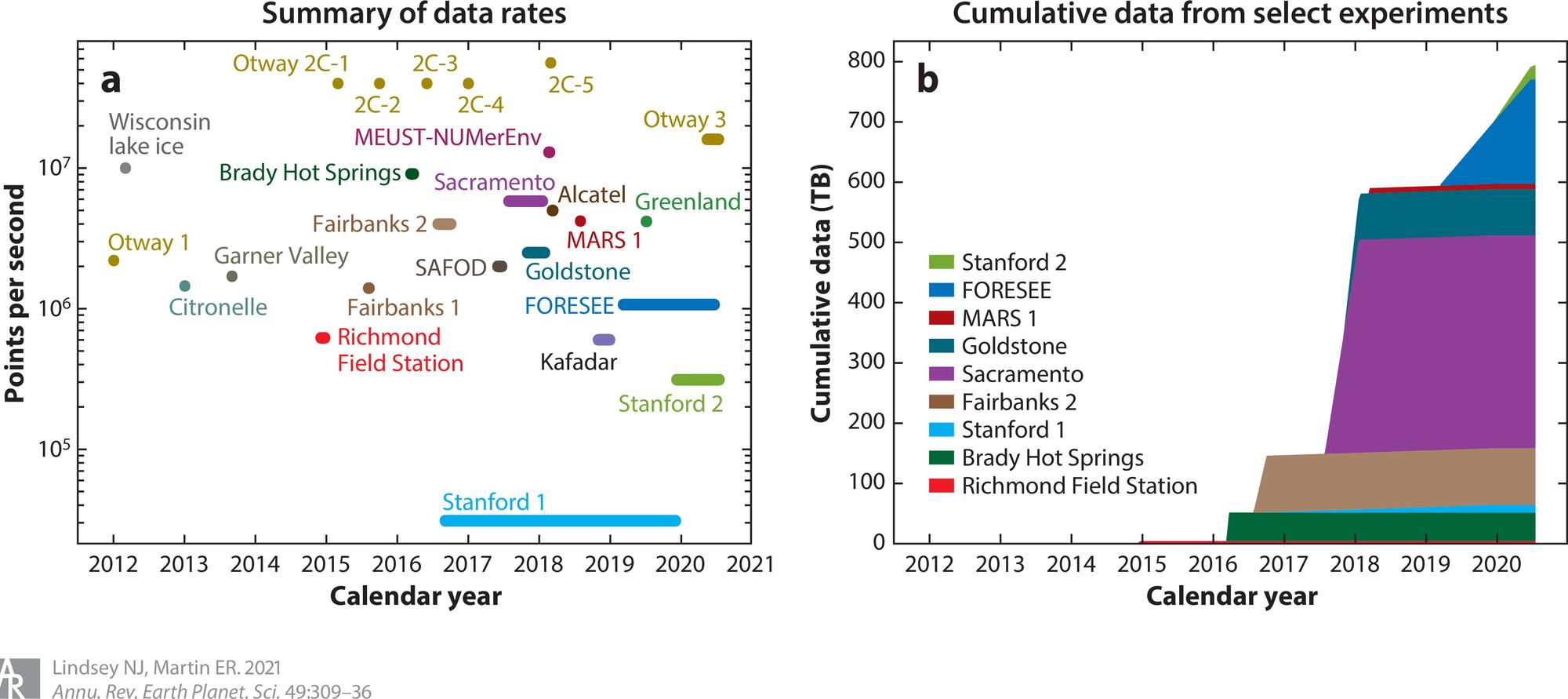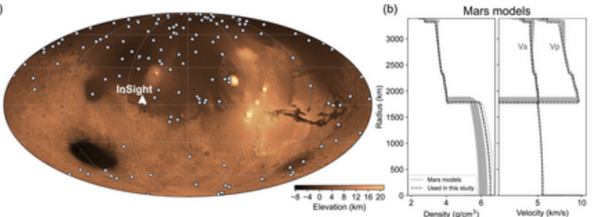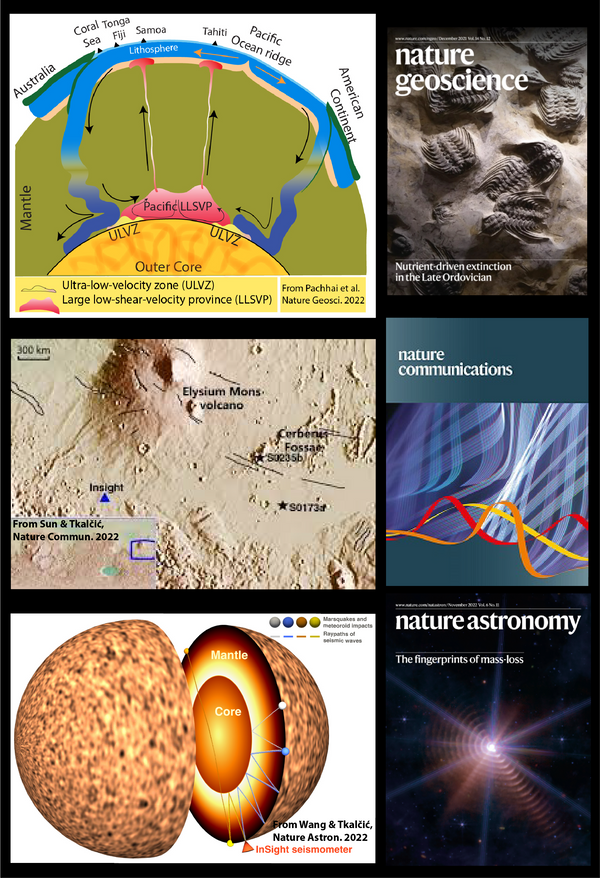Lighting Up Dark Fibre for Seismic Imaging
How DAS is used in seismology
By attaching a DAS integrator unit, in the example above a Silixa iDAS that is part of the AuScope ANSIR equipment pool, to a fibre optic cable, the entire cable becomes a sensing element. As a seismic wave disturbs the ground, the cable is stretched and compressed. The iDAS instrument measures the response of the cable to the external forces applied to it by sending a pulsed coherent optical laser signal to accurately measure the phase and amplitude of vibrations by detecting changes in Rayleigh scattering induced by extensional strain. The iDAS sends laser signal pulses along the cable and continuously monitors the phase and amplitude of the Rayleigh scattering from the backscattered light (Figure 1).

This technology can either repurpose long sections (1-10s of kilometres) of "dark" or unused telecommunication cable, or shorter length cables deployed for a dedicated experiment. In either case, the DAS instrument is patched on to a cable and this transforms the cable into thousands of individual sensors (“large-N”) with approximately 1 meter spacing.
Applications of DAS are still in their infancy but fascinating new results from experiments by earthquake seismologists (e.g. Lindsey et al., 2017; Ajo-Franklin et al., 2019; Zhan, 2020) are showing the amazing potential of this technique for a range of applications including fine-scale structural imaging of the Earth’s subsurface, earthquake monitoring, and geo-hazard assessment.
"Large-N" + "Large-T" = Big Data
In order to fundamentally advance our understanding of the Earth’s structure and evolution, and address its complexity and heterogeneity, significantly more comprehensive data are required to create fine-scale images of the Earth at depth. A new concept and strategy in seismology over the past few years are the implementation of “large-N” arrays, where “large-N” refers to 1-2 orders of magnitude more instruments per experiment. These large arrays using “seismic nodes” are becoming a fundamental tool in modern earthquake seismology for imaging, detecting micro-seismicity, and monitoring changes in subsurface properties (eg. Hansen & Schmandt, 2015). However, these “large-N” nodal-type seismic experiments use small, autonomous seismometers are limited by battery life (~1 month) and manual deployment, therefore the logistic limitations usually prevent long duration, or “large-T”, experiments. Now, we can use distributed acoustic sensing (DAS) to provide both "large-N" and "large-T" using fibre-optic cables.
This results in one of the major challenges of using DAS - the large volume of data recorded, as is shown in Figure 2 from Lindsey and Martin (2021). As these sensors record terabytes of seismic data with meter-scale sensor spacing per day, this demands a new fundamental theoretical framework to process and analyse the large quantity of data. It also provides an opportunity for development of new data analysis methods with the potential to make novel observations of the Earth. Volumes of data this size require strategic and innovative processing, which can be addressed in collaboration with the National Computing Infrastructure (NCI).

Planned Experiments & Applications
The Future Fellowship will be focused three overarching experiments that will be conducted: locally in Canberra at NASA/CSIRO Deep Space Network Facility; at the ANU run Warramunga Seismic Station, and in New Zealand's Deep Fault Drilling Project focusing on different aspects of DAS applications and design.
Our first experiment was at the Deep Space Network Facility run by NASA and CSIRO, just south of Canberra. This successful initial test recorded the regional distance M2.6 earthquake near Jindabyne, NSW (Figure 3) as well as traffic noise, quarry blasts, and teleseismic earthquakes.

As earthquake seismology applications of DAS recordings are still very new, it is essential to design experiments that provide data comparisons from multiple instruments and benchmark the quality and fidelity. At the ANU's Warramunga Seismic Station in the Northern Territory, the remote location and high-quality, permanent array of seismometers at Warramunga makes it an ideal location for such an experiment.
With colleagues at the University of Victoria in New Zealand we will use the ~900 m fibre optic cable deployed into the fault zone, which is part of the Deep Fault Drilling Project, to record earthquakes inside the fault zone and image its structure.
This Future Fellowship project will advance cutting-edge DAS technology and big data processing to develop unprecedented high-resolution images of the Earth. These powerful new information sources will advance our ability to model geo-hazards, detect earthquakes and nuclear explosions, refine models of resource location and emplacement, understand earthquake behaviour, and perform subsurface monitoring. The project will develop Australian research capability and competitive advantage in this fast-moving new area of seismic imaging.
References
Ajo-Franklin, J.B. et al. (2019). Distributed Acoustic Sensing Using Dark Fiber for Near-Surface Characterization and Broadband Seismic Event Detection, Scientific Reports 9, 1328.
Hansen, S.M. & Schmandt, B. (2015). Automated detection and location of microseismicity at Mount St. Helens with a large-N geophone array, Geophys. Res. Lett. 42, 7390-7397. 10.1002/2015gl064848.
Lindsey, N.J. et al. (2017). Fiber-Optic Network Observations of Earthquake Wavefields, Geophys. Res. Lett. 44, 11,792-711,799. 10.1002/2017GL075722.
Lindsey, N.J. & Martin, E.R. (2021). Fiber-Optic Seismology, Annual Review of Earth and Planetary Sciences 49, 309-336. 10.1146/annurev-earth-072420-065213.
Zhan, Z. (2020). Distributed Acoustic Sensing Turns Fiber‐Optic Cables into Sensitive Seismic Antennas, Seismo. Res. Lett. 91, 1-15.
More information




